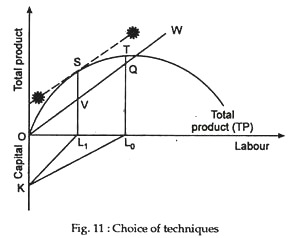This article will help you to learn about the difference between employment and saving.
Difference between Employment and Saving
The potential conflict between employment and saving is illustrated in Fig. 11.
Consider the use of a given amount of investible resources OK and the possibility of employing those resources with varying amounts of labour to produce output. OO is the production function in the consumption sector exhibiting diminishing returns to labour.
ADVERTISEMENTS:
Now assume that in the industrial sector labour is paid a fixed wage which is all consumed so that a ray from the origin (OC) with a constant slope (w) shows the level of the wage bill and consumption at each level of employment.
The difference between OO and OC is profit; and if all profits are saved the difference also shows the level of saving at each capital-labour ratio. Saving is maximised where a line drawn parallel to OC is tangential to the production function—at employment level OL in Figure 11. Beyond this point further employment generation would diminish the level of saving and investible surplus.
If the production function in Figure 11 is denoted algebraically as:
0 = aL – bL2 … (1)
ADVERTISEMENTS:
and the savings function as:
S = aL – bL2 – wL … (2)
the level of employment which maximises saving is obtained by differentiating equation (2) with respect to L and setting equal to zero which gives
δS = a – 2bL-w = 0 … (3)
ADVERTISEMENTS:
Therefore the level of employment which maximises saving is:
L = a – w/2b … (4)
Since L < L1, there is a conflict between savings and employment maximisation. As Thirwall has put it, “The more labour-intensive technique maximises output and consumption in the short run; but the more capital-intensive technique provides a greater surplus for reinvestment for growth and future output and consumption.”
Prediction:
The upshot of current discussion on the choice of techniques is that, it is not possible to make an invariable choice in favour of more labour-intensive techniques even in overpopulated countries, unless we make explicit choices between present and future.
The more we value raising the present consumption level and current employment against future growth, the more we should favour labour-intensive techniques. To quote H. Myint: “The ‘common sense’ view that overpopulated countries should always prefer labour- intensive methods conceals an implicit preference for present over future, and represents a very short ‘planning horizon’. On the longer ‘planning horizon’, the more we value the future rate of growth over the present level consumption and employment, the more we should favour capital-intensive methods which are capable of yielding a larger surplus of output over wages costs for a given capital outlay and so make possible a higher rate of re-investment for the future.”
